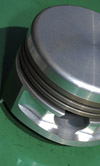Piston challenges more prevalent on Cup open engine
 Toyota Racing Development's MAHLE Motorsports pistons are somewhat similar to the 2618 material typically used in NASCAR Sprint Cup applications, according to Brad Green at MAHLE's Fletcher, North Carolina American headquarters. As TRD continues to try and gain performance edges while having to deal with shrinking budgets - as everyone does these days - using exotic materials just isn't the route to take.
Toyota Racing Development's MAHLE Motorsports pistons are somewhat similar to the 2618 material typically used in NASCAR Sprint Cup applications, according to Brad Green at MAHLE's Fletcher, North Carolina American headquarters. As TRD continues to try and gain performance edges while having to deal with shrinking budgets - as everyone does these days - using exotic materials just isn't the route to take.
Still, according to David Currier, TRD's vice president of engine engineering, the specs change on these pistons about three times each season for open configurations and about twice annually on the plate engines. "We change our specifications fairly frequently because if we change our head geometry, that changes the crown shape; we change chamber shapes from time to time, as well as valve lift, which changes pocket depth. Of course we're always working on friction, slip skirt shape and rings so we're continually evolving those things."
Currier admits there are more challenges with the open engine - used far more often than plate configurations - but the pistons, he noted, aren't that difficult to deal with because of the mandated 400-gram weight for all configurations. No matter the configuration, TRD uses its pistons for a single use of one race weekend. "Structurally speaking, there aren't any big problems with the pistons; certainly, wear relative to skirts and optimizing the complex three-cam shape is a continual battle in adjustment. But as the engine changes we change the crown shape and that changes some of the structure so it will flex differently," he told me.
Working together with their supplier, TRD has verbal discussions of "take a little off this area" and occasionally makes a proposal based on their post-race teardowns. "It just depends on who's got the experience and what it is we're seeing," in regard to wear. "If it's something they are better at than we are, then we let them use their expertise. If it's something we feel we have more knowledge about - or a stronger opinion about - then we'll dictate it more."
Currier emphasized that changes to the piston skirt design has to be a balance between cost and logistics, because there are races nearly every weekend between February and November on the NASCAR trail. "We try to do fewer steps but bigger steps" when a piston redesign is called for. "Just because of the costs," Currier said. "Trying to control our costs and get our budgets further refined and further down as they tend to be going. If we change every weekend, then we have spare engines that need to be changed and there is a lot of cost with that."
When TRD does change piston design, "It might be due to other things that cause the piston to be changed, like a combustion chamber change, or the head's a bit different and the valves are different. Those things usually go as part of a package."
Fig. 1 - TRD's piston specifications change a few times each season (Photo courtesy of Toyota Racing Development)
Written by Anne Proffit